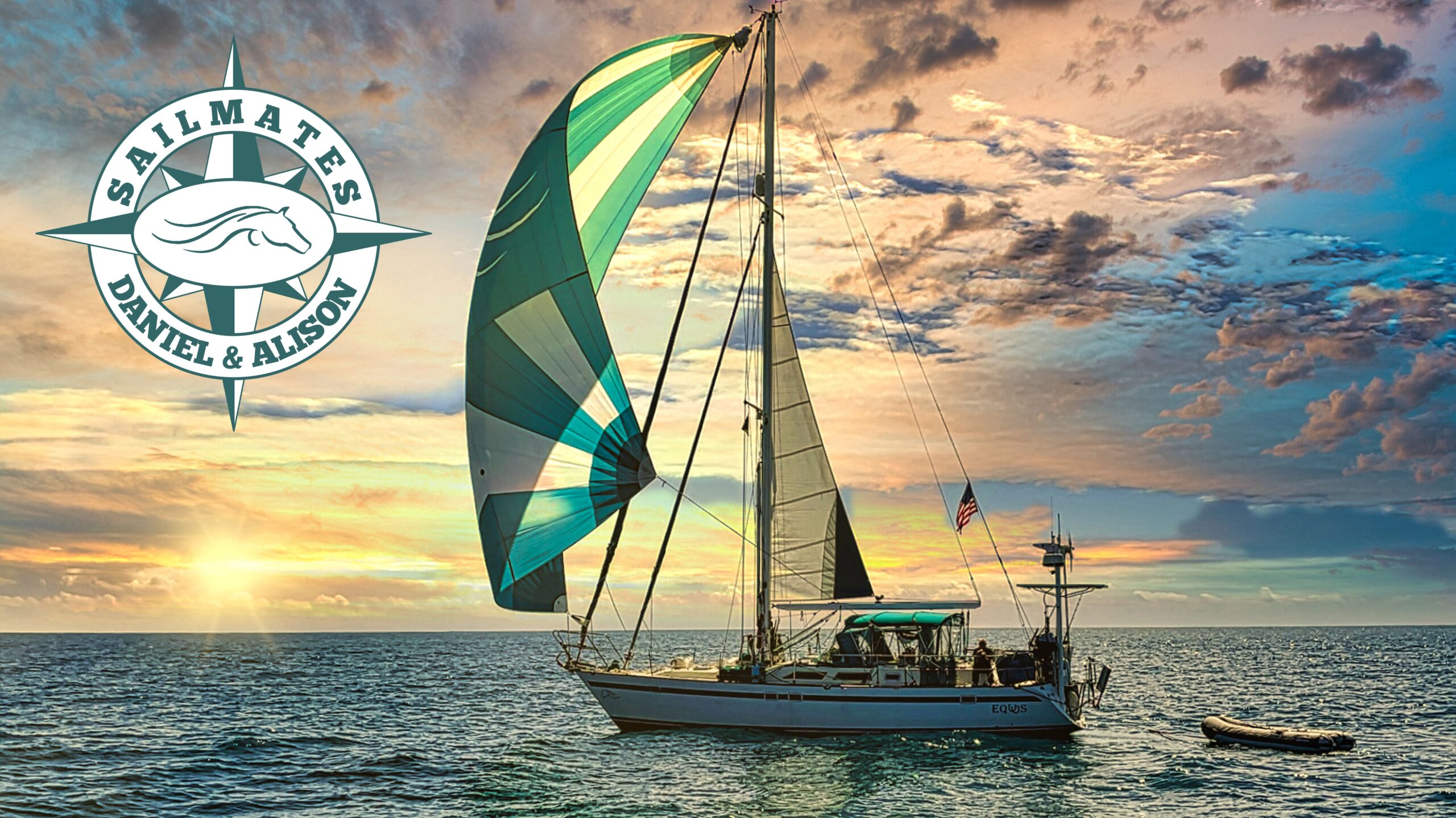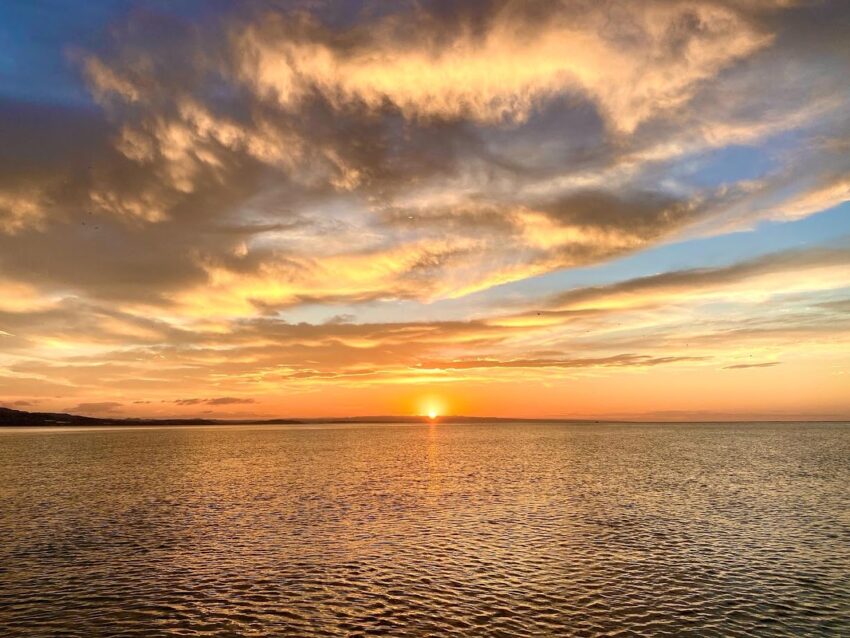“In the vastness of the sea, we find our strength not just in calm waters, but in the storms that test our resolve.” Alison Gieschen
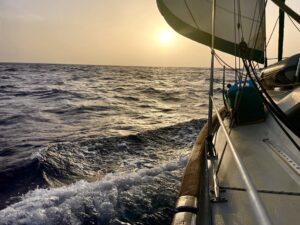
Sailing across the vast sea with our new system guiding us was a wonderful feeling. After four years of long and unexpected delays in Europe and the Mediterranean, our hopes soared as we prepared to resume our circumnavigation. This lifestyle constantly challenges us with bad weather, broken parts, and unpredictable situations. The past few months have been a whirlwind of highs and lows, reflecting the unpredictable nature of our sailing adventures.
CROSSING THE ATLANTIC
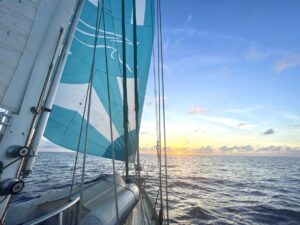
We settled into a simple routine of night watches. I went to bed around seven or eight each evening. Dan would wake me around 3:00 AM and I would take watch the rest of the night until Dan woke up later that morning. I got plenty of sleep and loved the schedule of only taking one night shift and being awake for the sunrise. I love to watch the new day dawning. There is something magical about watching the sunrise.
Watches were easy as the weather cooperated and we saw only four other ships during our passage. One night, a merchant ship was on a collision course with us. I spotted it on our AIS (Automatic Identification System) which tells you the ship name, its course, and how far it will pass from your boat. At forty miles out, we were in its path. I jumped the gun a bit and went down and woke up Dan. He came up and took one look at how far away it was and grumbled something about it being too far away to worry about yet, and went back to bed.
I realized my mistake and waited for the ship to get closer. Since these ships travel at 15 to 20 miles an hour and we were making five knots going toward it, it only took about an hour before we were close enough for me to be really concerned. I vowed not to wake Dan up. I wanted to be a big girl and handle this by myself. When the ship was less than two miles away and we were still on a collision course, I decided it was time to hail the ship on the radio. As a sailboat, we have the right of way and he must avoid us. I was not going to leave it to chance that it altered course.
Just as I was reaching for the radio, a foreign-accented voice called “Equus (pronounced e-cuse) Equus, Equus.” I breathed a sigh of relief that the ship was aware of our presence and had contacted us.
I had a brief dialogue with the ship. They asked me if it was okay if they passed to our stern on their port side. I replied, “Of course,” as that is where they should be passing to give us room. When I looked at the AIS screen, they had altered course but were still going to clear us by half a mile. While this may seem like a huge distance, when you are on a tiny boat being passed by a thousand-foot vessel, it seems way too close.
As the ship passed abreast of us, lit up like a city, it towed into the sky like a skyscraper. It made me realize what a tiny speck we were on the surface of the ocean compared to that vessel. Thanks to modern electronics, we are able to stay safe as long as we remain alert. Hence the reason for night watches. I was proud that I resolved the situation myself and didn’t wake up Dan again. I AM the bravest coward I know.
Fishy Fish Everywhere
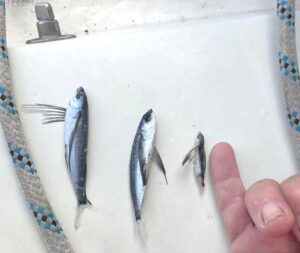
We did have a few tense moments when the wind went from calm to a rising intensity. At a wind strength was less than 15 knots, we fly our giant spinnaker. Our horse head flew above us as our sea pony pulled us across the water with greater speed than could our other sails. As the wind increase one evening, we had to react quickly and get the spinnaker down before we got overpowered. The result was some unfortunate breakages and loss of halyards that got our hearts racing and adrenaline flowing, nothing major just inconvenient. As soon as the situation was resolved, we drifted, like our boat, back into the ebb and flow and routine of the passage.
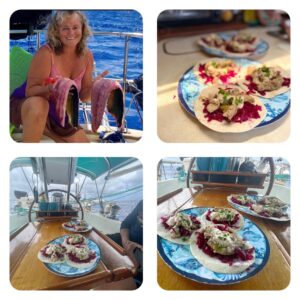
I made it my morning routine to wander the deck and retrieve the bodies. Sometimes there were fairly large victims, others were as tiny as my pinky. When I tossed them overboard and looked at the height of our deck and saw how far these little guys had to fly to reach it, I was amazed. Those I didn’t find right away, hidden beneath something on the deck, it wasn’t as pleasant discovering and discarding them after they began to decay.
Our very limited moments of excitement involved catching fish. We watched a Mahi bite off our brand-new lure. We caught a medium-sized fish which we could not identify for sure, but it tasted great. And Dan managed to land a 20-pound tuna which I delighted in cooking for a week straight. Other than a few pods of dolphins taking time to play in our bow wake, time was gauged by the rising and the lowering of the sun.
Landfall – Barbados
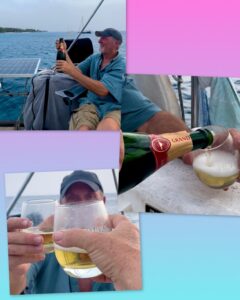
The land remained hidden in the misty fog until we were very close. The island of Barbados finally emerged in a hazy outline. From our view, it did not have the appearance of an exotic tropical island. All I could make out of the shoreline were some rugged tree-covered hills. I guess I was expecting palm trees, white sandy beaches, and brilliant sunshine after traveling over 2,000 miles to land in the Caribbean. I have come to learn that my expectations and the realities of this journey are often on opposite ends of the spectrum.
We motored to the west side of the island and found the quaint harbor of Port St. Charles, one of only two harbors where sailboats can anchor in Barbados. I finally was able to see the colorful Caribbean-style harbor I had been dreaming about. Unfortunately, the bottom, while sandy, had rock just beneath the surface. We had to make three anchoring attempts before we got the anchor to hold. We had very little strength or energy which made the process much worse than it probably should have been; I MAY have been a little testy by our third attempt.
As soon as we were secure, and food in our bellies, we retreated to the stern just in time for sunset. We sat in our deck chairs. Dan popped the bottle of champagne we had saved for just this occasion and we toasted to a safe passage, a safe arrival, and hopefully, the beginning of magical adventures in the Caribbean. As always when a long passage has been completed, we slept that first night in an almost comatose state.
The Mysterious Barbados
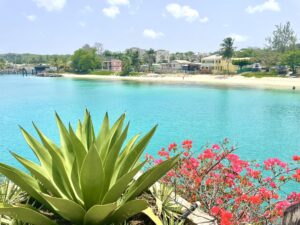
The island spans 166 square miles. Pristine beaches with powdery white sand and turquoise waters attract tourists worldwide, while the rugged east coast, shaped by the Atlantic Ocean, presents a dramatic contrast. Barbados has crystal-clear water and an incredible array of sea life. It is a snorkeling and diving paradise. We donned our scuba gear for the first time since we left the Caribbean in 2019 and relished diving in the warm water with beautiful reefs and vibrant fish right off our boat where we were anchored.
Barbadians, known as Bajans, are known for their warmth, and friendliness. Even the customs officials were kind and welcoming. They seemed very concerned that we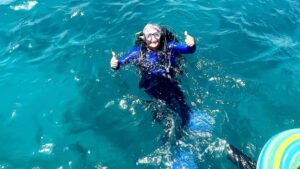
This island is pricey so we did not stay long, just a week, before we headed off to our next destination. We pulled up anchor at noon and in one overnight passage, we arrived the next morning at the island of Canouan, part of the Grenadines south of Saint Vincent.
Sailing in the Caribbean Islands
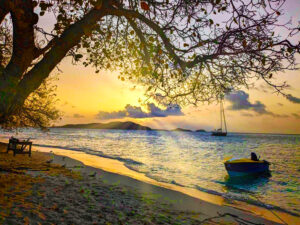
We checked into the country of Saint Vincent in Canouan, a small and very poor island. We only stayed a day before sailing a few miles to Tortuga Cay which is part of an extensive marina park. It has a huge population of sea turtles as the name suggests. We had to pay a fee to be in the park; we got a three-day pass. For three glorious days, we snorkeled, donned our scuba gear, and had amazing encounters with tons of sea turtles. We dove on vibrant reefs brimming with colorful sea life. It was a little slice of heaven.
One of the huge attractions in Tortuga Cay is the beach restaurants. The smell of grilled delights drifted to the boats in the harbor during the day. Fishermen were busily dinghying in freshly caught fish for the nightly feast. Dinghies would drive up to your anchored boat and knock on your hull. A dark-skinned native would say “Hey mon, you need to come to the beach tonight and have dinner.” We made our reservation, totally charmed by the invitation.
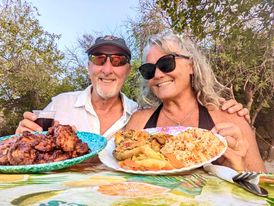
Bequia was another gorgeous island we visited during our island hopping. We ended up staying there for a couple of weeks. It was so gorgeous and peaceful that we felt as if we could rest there forever. The beautiful, white sand beaches were lined with restaurants and pubs. We could pick and choose which beachside bar we would spend happy hour, or simply sit on the stern of our boat and take in the views.
The harbor faced west so we took delight in the magnificent sunset show each night. The harbor is usually quite busy as many sailors come to Bequia to spend extended stays. You can’t blame them as you will want for nothing. The harbor is protected. You have fresh fruits and veggies sold streetside. There are beautiful trails to hike into the mountains. The water is warm and crystal clear. We had gorgeous reefs to snorkel and dive on. Life was so peaceful and perfect there I was hesitant to pull up anchor. However, there was a lot more of paradise to explore. Sadly, Bequia would be meeting Hurricane Beryl soon and most of the town and the beautiful beach restaurants would be damaged.
From Bequia, we headed south to Carriacou. Since Carriacou is part of the Grenada Islands, we had checked out at Bequia and checked in to Grenada at Tyrell Bay, Carriacou. Once legal, we headed north again to see the islands we had to skip. Our first anchorage was another marina park which was a strip of white sand with a few palm trees on it aptly named “Sandy Island.” This tiny strip of island was surrounded by gorgeous reefs. We were treated to more great snorkeling and incredible marine life.
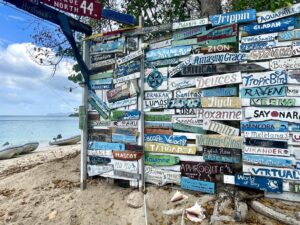
We went to the event with a few of the sailors we had met at the anchorage and had an incredible evening. The painting was fun, the beverages delightful and our meal was delicious. The entire experience was a five out of five. Unfortunately, Paradise Restaurant was about to take a direct hit from the looming category five hurricane Beryl. Thankfully, we were not there for that devastating event. All the painted boat plaques have been erased from history.
Bracing for Impact: Preparing for the Impending Hurricane
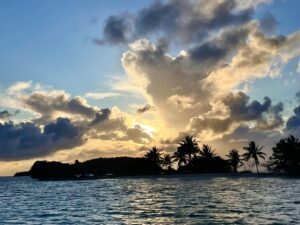
We had a trip scheduled to fly back to the US for two weeks and needed to leave our boat somewhere safe as we were traveling in the middle of June. It is not advisable to leave your boat unattended at anchor in a foreign country. The chance of a hurricane arriving was slim to none. Hurricanes do not usually ramp up until August and September, the most active months for hurricanes.

While visiting my mom, she organized a Happy Hour Sea Stories event at her retirement community. We filled the room, told our stories, and sold all the copies of our books that we had mailed to her apartment. We had an enthusiastic audience that loved our stories. We are so grateful to everyone who attended and encouraged us. They warmed our hearts with their compliments.
Preparing for a Hurricane
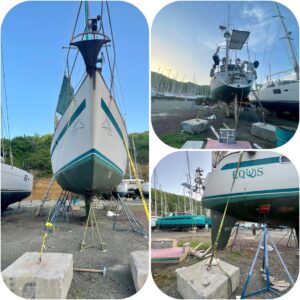
I was terrified. Hurricane Beryl had developed into a category five hurricane and we were in its path. I’ve seen pictures of boatyards where hurricanes have ripped through. There is usually not a boat standing after the event. As we were living on our boat, twenty feet in the air, I was afraid that our boat would get knocked over with us inside. To give the marina credit, they did an excellent job of tying each boat to huge cement blocks fore and aft. The boatyard is surrounded by massive cliffs, protecting it from the wind. What we did not know, was whether it would be enough.
Beryl was due to arrive Monday during the day. As we waited, secured and ready as we could be, we formed a backup plan. If things got too bad, we would abandon our boat and go to a house just outside the marina used for the security staff. We were told we could take refuge there if needed. This provided me with some consolation that we would not have to go down with our ship.
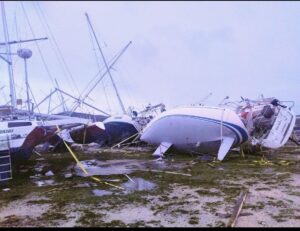
We remained in our boat during the hurricane. We never even felt threatened to leave. The walls protected us from all the wind. Wind hit in the 60-mph range in the harbor next to us where boats dragged anchor and were damaged, but our walls completely sheltered us. We had our wind gauge on during the storm and the highest reading we saw was 27 knots. That wind gust lasted about three seconds. The tops of the hills we could see from our boat took extensive damage, trees fell, and roads collapsed, but we were safely nestled in the most protected place on the island.
What’s Next for Equus
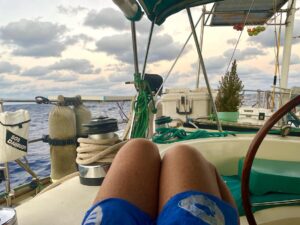
All will be resolved and we will be back in the water soon. We will continue to explore the southern Caribbean islands as we make our way toward South America. Our plan is to go through the Panama Canal and into the Pacific next spring.
My Inspiration
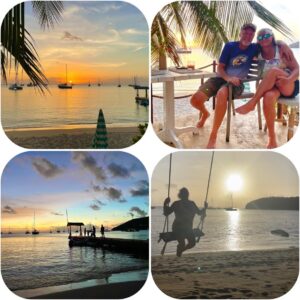
The basics of what she told me was that she understands how the power of positive thinking can truly change your life, mentally and physically. As I sat there, dwelling on my current irritations, I thought how miraculous it was that my mother called, when I most needed it and reminded me how important it is to stay positive. You can’t always control what is happening in your life. It can be hurricanes, boat parts breaking, or any unfortunate event. What you do have control over is how you view the situation. You can be grateful for what you do have. You can think positive thoughts. You can believe that you will overcome and gain strength. She was a breath of fresh air in a stagnant moment; just what I needed to jar myself out of my self-pity. I have so much to be thankful for, and so much to look forward to, there is no need to let temporary discomfort dictate my outlook and my feelings.
I revised my post, changed my attitude, and had a wonderful evening with my husband. We are looking forward to being back in the water soon, and we will let these cloudy waters pass under our hull. We have been through tougher times than these and we have made it this far. We knew this adventure would not be easy. There is quite a contrast between the beauty and our beasts and we need to accept each as part of the journey.
Thank you, mother, for your wisdom, strength, and your understanding of how to navigate through turbulent times. You continue to be my role model. You awe me with your passion for life, learning, and improving the quality of life. You will always be my hero.
Fair winds,
Alison and Dan
S/V Equus

